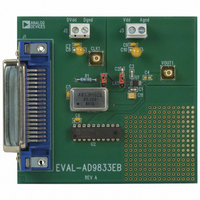EVAL-AD9833EBZ Analog Devices Inc, EVAL-AD9833EBZ Datasheet - Page 10

EVAL-AD9833EBZ
Manufacturer Part Number
EVAL-AD9833EBZ
Description
BOARD EVAL FOR AD9833
Manufacturer
Analog Devices Inc
Datasheet
1.AD9833BRMZ.pdf
(24 pages)
Specifications of EVAL-AD9833EBZ
Main Purpose
Timing, Direct Digital Synthesis (DDS)
Embedded
No
Utilized Ic / Part
AD9833
Primary Attributes
10-Bit DAC, 28-Bit Tuning Word Width
Secondary Attributes
25MHz, Graphical User Interface, 2.3 V ~ 5.5 V
Lead Free Status / RoHS Status
Lead free / RoHS Compliant
Other names
EVAL-AD9833EB
EVAL-AD9833EB
EVAL-AD9833EB
Available stocks
Company
Part Number
Manufacturer
Quantity
Price
Company:
Part Number:
EVAL-AD9833EBZ
Manufacturer:
Analog Devices Inc
Quantity:
135
AD9833
TERMINOLOGY
Integral Nonlinearity
This is the maximum deviation of any code from a straight line
passing through the endpoints of the transfer function. The
endpoints of the transfer function are zero scale, a point 0.5 LSB
below the first code transition (000 . . . 00 to 000 . . . 01), and
full scale, a point 0.5 LSB above the last code transition (111 . . .
10 to 111 . . . 11). The error is expressed in LSBs.
Differential Nonlinearity
This is the difference between the measured and ideal 1 LSB
change between two adjacent codes in the DAC. A specified
differential nonlinearity of ±1 LSB maximum ensures
monotonicity.
Output Compliance
The output compliance refers to the maximum voltage that can
be generated at the output of the DAC to meet the specifications.
When voltages greater than that specified for the output
compliance are generated, the AD9833 may not meet the
specifications listed in the data sheet.
Spurious-Free Dynamic Range (SFDR)
Along with the frequency of interest, harmonics of the
fundamental frequency and images of these frequencies are
present at the output of a DDS device. SFDR refers to the largest
spur or harmonic present in the band of interest. The wideband
SFDR gives the magnitude of the largest harmonic or spur relative
to the magnitude of the fundamental frequency in the zero to
Nyquist bandwidth. The narrow-band SFDR gives the attenuation
Rev. C | Page 10 of 24
of the largest spur or harmonic in a bandwidth of ±200 kHz
about the fundamental frequency.
Total Harmonic Distortion (THD)
THD is the ratio of the rms sum of harmonics to the rms value
of the fundamental. For the AD9833, THD is defined as
where V1 is the rms amplitude of the fundamental and V
V
sixth harmonics.
Signal-to-Noise Ratio (SNR)
SNR is the ratio of the rms value of the measured output signal
to the rms sum of all other spectral components below the
Nyquist frequency. The value for SNR is expressed in decibels.
Clock Feedthrough
There will be feedthrough from the MCLK input to the analog
output. Clock feedthrough refers to the magnitude of the MCLK
signal relative to the fundamental frequency in the output
spectrum of the AD9833.
4
, V
THD
5
, and V
=
6
20
are the rms amplitudes of the second through
log
V
2
2
+
V
3
2
+
V
V
4
1
2
+
V
5
2
+
V
6
2
2
, V
3
,





















